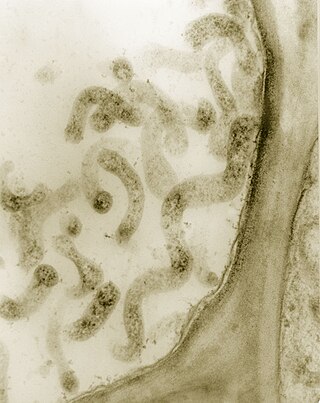| Gemmatales | |
|---|---|
| Scientific classification | |
| Domain: | Bacteria |
| Phylum: | Planctomycetota |
| Class: | Planctomycetia |
| Order: | Gemmatales Dedysh et al. 2020 [1] |
| Families [2] | |
Gemmatales is an order of bacteria.
| Gemmatales | |
|---|---|
| Scientific classification | |
| Domain: | Bacteria |
| Phylum: | Planctomycetota |
| Class: | Planctomycetia |
| Order: | Gemmatales Dedysh et al. 2020 [1] |
| Families [2] | |
Gemmatales is an order of bacteria.
Chrysiogenaceae is a family of bacteria.

Entomoplasmatales is a small order of mollicute bacteria.

The order Flavobacteriales comprises several families of environmental bacteria.
The Sphingobacteriales is an order of environmental bacteria.
Planctomycetales is an order of bacteria.
The Negativicutes are a class of bacteria in the phylum Bacillota, whose members have a peculiar cell wall with a lipopolysaccharide outer membrane which stains gram-negative, unlike most other members of the Bacillota. Although several neighbouring Clostridia species also stain gram-negative, the proteins responsible for the unusual diderm structure of the Negativicutes may have actually been laterally acquired from Pseudomonadota. Additional research is required to confirm the origin of the diderm cell envelope in the Negativicutes.
Acidothermus cellulolyticus is a species of gram-variable bacteria. It is the only member of the genus Acidothermus and the family Acidothermaceae.
The Nakamurella is a genus of bacteria.
The Selenomonadales are an order of bacteria within the class Negativicutes; unlike most other members of Bacillota, they are Gram-negative. The phylogeny of this order was initially determined by 16S rRNA comparisons. More recently, molecular markers in the form of conserved signature indels (CSIs) have been found specific for all Selenomonadales species. On the basis of these markers, the Selenomonadales are inclusive of two distinct families, and are no longer the sole order within the Negativicutes. Several CSIs have also been found specific for both families, Sporomusaceae and Selenomonadceae. Samples of bacterial strains within this order have been isolated from the root canals of healthy human teeth.
The Natranaerobiales are an order of bacteria placed within the class Clostridia. This order contains the thermophilic bacterial species Natranaerobius thermophilus and the related species Natranaerobaculum magadiense.
Phycisphaeraceae is a family of bacteria.
Iodidimonas is a genus of bacteria that oxidizes iodide to iodine. It was isolated from iodide-rich brine associated with natural gas in Kujukuri, Japan.
The Frankiales are an order of bacteria, containing three monotypic families, each with only one genus. The order consists of slow-growing aerobic to microaerophilic, soil-inhabiting mesophilic organisms that are in symbiosis with pioneer plants.
The Geodermatophilales are an order of bacteria. Members of the order are Gram-positive, aerobic, and can be motile. They mainly inhabit arid and degraded habitats but also marine and plant-associated environments. Members have pigmented colonies.
Isosphaeraceae is a family of bacteria.
Pirellulales is an order of bacteria.
Lacipirellulaceae is a family of bacteria.
Thermoguttaceae is a family of bacteria.
The Pirellulaceae are a family of bacteria.
Holophagae is a class of Acidobacteriota.